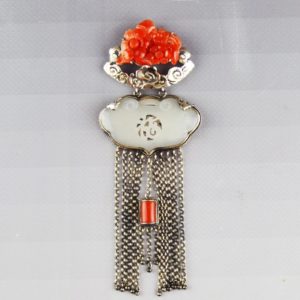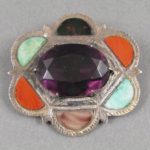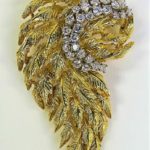
A Hetian jade carved pendant in the form of flowers, carved pendant set onto a dangling brooch.
Sold for $550.00 at Jambhala Antique & Jewelry, Inc
Of the many different varieties of Chinese jade, Hetian jade is considered to be one of the most valuable, and also happens to be the most well-known of jade varieties. For most of time, Hetian jade was a term used only to refer to jade mined from the Kunlun Mountains of Xinjiang, in the Western Autonomous Region of China that borders Mongolia and Russia. The exquisite material mined from Xinjiang has been prized for thousands of years for its greasy luster and exceptionally strong color. The name ‘Hetian’ jade was assigned after the transliteration of the small oasis town of Hotan or ‘Hetian’, which is located in South-Western Xinjiang. Since it is also named Hotan (or Hetian), Hetian jade may sometimes be referred to as Hotan jade as well. Reference: Gem Select
Nephrite and jadeite were used from prehistoric periods for hardstone carving. Jadeite has about the same hardness as quartz. Nephrite is slightly softer but tougher (more resistant to breakage) than jadeite. It was not until the 19th century that a French mineralogist, Alexis Damour (1808-1902), determined that “jade” was in fact two different minerals.
Among the earliest known jade artifacts excavated from prehistoric sites are simple ornaments with bead, button, and tubular shapes. Additionally, jade was used for adze heads, knives, and other weapons, which can be delicately shaped. As metal-working technologies became available, the beauty of jade made it valuable for ornaments and decorative objects including brooches and other jewellery. Jadeite measures between 6.0 and 7.0 Mohs hardness, and nephrite between 6.0 and 6.5, so it can be worked with quartz or garnet sand, and polished with bamboo or even ground jade. Reference Wikipedia.
Nephrite can be found in a creamy white form (known in China as “mutton fat” jade) as well as in a variety of light green colours, whereas jadeite shows more colour variations, including blue, red, black, dark green, lavender and white. Of the two, jadeite is rarer, documented in fewer than 12 places worldwide. Translucent emerald-green jadeite is the most prized variety, both historically and today. As “quetzal” jade, bright green jadeite from Guatemala was treasured by Mesoamerican cultures, and as “kingfisher” jade, vivid green rocks from Burma became the preferred stone of post-1800 Chinese imperial scholars and rulers. Burma (Myanmar) and Guatemala are the principal sources of modern gem jadeite. In the area of Mogaung in the Myitkyina District of Upper Burma, jadeite formed a layer in the dark-green serpentine, and has been quarried and exported for well over a hundred years. Canada provides the major share of modern lapidary nephrite. Nephrite jade was used mostly in pre-1800 China as well as in New Zealand, the Pacific Coast and the Atlantic Coast of North America, Neolithic Europe, and Southeast Asia. In addition to Mesoamerica, jadeite was used by Neolithic Japanese and European cultures.


